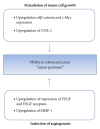The role of peroxisome proliferator-activated receptors in colorectal cancer
- PMID: 23024650
- PMCID: PMC3447370
- DOI: 10.1155/2012/876418
The role of peroxisome proliferator-activated receptors in colorectal cancer
Abstract
Colorectal cancer is one of the most common cancers in the world. Dietary fat intake is a major risk factor for colorectal cancer. Some nuclear hormone receptors play an important role in regulating nutrient metabolism and energy homeostasis. Among these receptors, special attention has been focused on the role of peroxisome proliferator-activated receptors (PPARs) in colorectal cancer, because PPARs are involved in regulation of lipid and carbohydrate metabolism. PPARs are ligand-activated intracellular transcription factors. The PPAR subfamily consists of three subtypes encoded by distinct genes named PPARα, PPARβ/δ, and PPARγ. PPARγ is the most extensively studied subtype of PPARs. Even though many investigators have studied the expression and clinical implications of PPARs in colorectal cancer, there are still many controversies about the role of PPARs in colorectal cancer. In this paper, the recent progresses in understanding the role of PPARs in colorectal cancer are summarized.
Figures
Similar articles
-
Peroxisome proliferator-activated receptor gamma: promising target in glioblastoma.Panminerva Med. 2018 Sep;60(3):109-116. doi: 10.23736/S0031-0808.18.03462-6. Panminerva Med. 2018. PMID: 30176701 Review.
-
Peroxisome proliferator-activated receptor gamma in bladder cancer: a promising therapeutic target.Cancer Biol Ther. 2009 Apr;8(7):6-15. doi: 10.4161/cbt.8.7.7853. Cancer Biol Ther. 2009. PMID: 19417560 Review.
-
The peroxisome proliferator-activated receptor beta/delta agonist, GW501516, regulates the expression of genes involved in lipid catabolism and energy uncoupling in skeletal muscle cells.Mol Endocrinol. 2003 Dec;17(12):2477-93. doi: 10.1210/me.2003-0151. Epub 2003 Oct 2. Mol Endocrinol. 2003. PMID: 14525954
-
Peroxisome proliferator-activated receptor (PPAR)β/δ, a possible nexus of PPARα- and PPARγ-dependent molecular pathways in neurodegenerative diseases: Review and novel hypotheses.Neurochem Int. 2013 Oct;63(4):322-30. doi: 10.1016/j.neuint.2013.06.012. Epub 2013 Jun 25. Neurochem Int. 2013. PMID: 23811400 Review.
-
Roles of the peroxisome proliferator-activated receptors (PPARs) in the pathogenesis of hepatocellular carcinoma (HCC).Biomed Pharmacother. 2024 Aug;177:117089. doi: 10.1016/j.biopha.2024.117089. Epub 2024 Jul 6. Biomed Pharmacother. 2024. PMID: 38972148 Review.
Cited by
-
PPARG expression in colorectal cancer and its association with staging and clinical evolution.Acta Cir Bras. 2020;35(7):e202000708. doi: 10.1590/s0102-865020200070000008. Epub 2020 Aug 17. Acta Cir Bras. 2020. PMID: 32813759 Free PMC article.
-
PPAR-α Modulators as Current and Potential Cancer Treatments.Front Oncol. 2021 Mar 23;11:599995. doi: 10.3389/fonc.2021.599995. eCollection 2021. Front Oncol. 2021. PMID: 33833983 Free PMC article. Review.
-
Overcoming the matched-sample bottleneck: an orthogonal approach to integrate omic data.Sci Rep. 2016 Jul 12;6:29251. doi: 10.1038/srep29251. Sci Rep. 2016. PMID: 27403564 Free PMC article.
-
Chiral phenoxyacetic acid analogues inhibit colon cancer cell proliferation acting as PPARγ partial agonists.Sci Rep. 2019 Apr 1;9(1):5434. doi: 10.1038/s41598-019-41765-2. Sci Rep. 2019. PMID: 30931956 Free PMC article.
-
The PPARα and PPARγ Epigenetic Landscape in Cancer and Immune and Metabolic Disorders.Int J Mol Sci. 2021 Sep 30;22(19):10573. doi: 10.3390/ijms221910573. Int J Mol Sci. 2021. PMID: 34638914 Free PMC article. Review.
References
-
- Jemal A, Bray F, Center MM, Ferlay J, Ward E, Forman D. Global cancer statistics. CA Cancer Journal for Clinicians. 2011;61(2):69–90. - PubMed
-
- Jemal A, Siegel R, Xu J, Ward E. Cancer statistics, 2010. CA Cancer Journal for Clinicians. 2010;60(5):277–300. - PubMed
-
- Parkin DM, Bray F, Ferlay J, Pisani P. Global cancer statistics, 2002. CA Cancer Journal for Clinicians. 2005;55(2):74–108. - PubMed
LinkOut - more resources
Full Text Sources
Other Literature Sources




